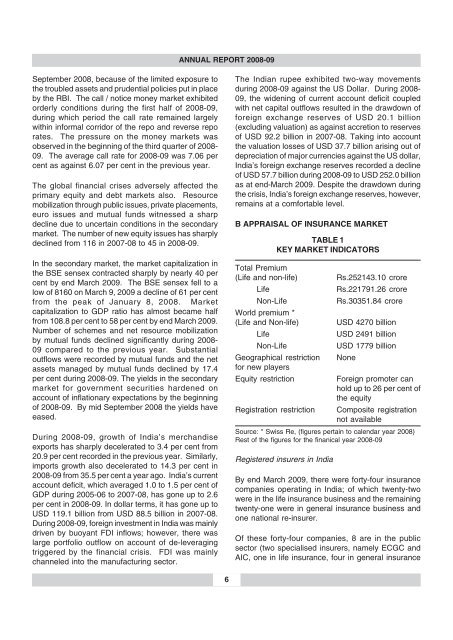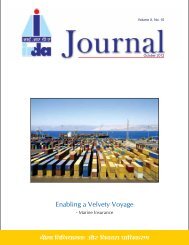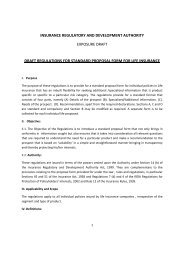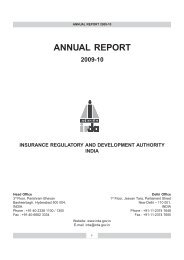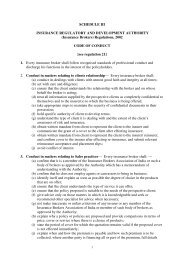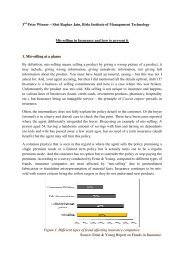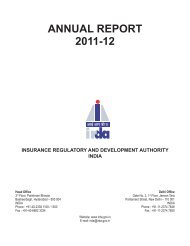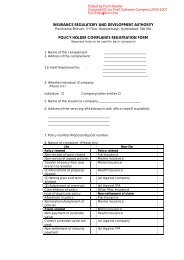annual report 2008-09 - IRDA
annual report 2008-09 - IRDA
annual report 2008-09 - IRDA
You also want an ePaper? Increase the reach of your titles
YUMPU automatically turns print PDFs into web optimized ePapers that Google loves.
ANNUAL REPORT <strong>2008</strong>-<strong>09</strong><br />
September <strong>2008</strong>, because of the limited exposure to<br />
the troubled assets and prudential policies put in place<br />
by the RBI. The call / notice money market exhibited<br />
orderly conditions during the first half of <strong>2008</strong>-<strong>09</strong>,<br />
during which period the call rate remained largely<br />
within informal corridor of the repo and reverse repo<br />
rates. The pressure on the money markets was<br />
observed in the beginning of the third quarter of <strong>2008</strong>-<br />
<strong>09</strong>. The average call rate for <strong>2008</strong>-<strong>09</strong> was 7.06 per<br />
cent as against 6.07 per cent in the previous year.<br />
The global financial crises adversely affected the<br />
primary equity and debt markets also. Resource<br />
mobilization through public issues, private placements,<br />
euro issues and mutual funds witnessed a sharp<br />
decline due to uncertain conditions in the secondary<br />
market. The number of new equity issues has sharply<br />
declined from 116 in 2007-08 to 45 in <strong>2008</strong>-<strong>09</strong>.<br />
In the secondary market, the market capitalization in<br />
the BSE sensex contracted sharply by nearly 40 per<br />
cent by end March 20<strong>09</strong>. The BSE sensex fell to a<br />
low of 8160 on March 9, 20<strong>09</strong> a decline of 61 per cent<br />
from the peak of January 8, <strong>2008</strong>. Market<br />
capitalization to GDP ratio has almost became half<br />
from 108.8 per cent to 58 per cent by end March 20<strong>09</strong>.<br />
Number of schemes and net resource mobilization<br />
by mutual funds declined significantly during <strong>2008</strong>-<br />
<strong>09</strong> compared to the previous year. Substantial<br />
outflows were recorded by mutual funds and the net<br />
assets managed by mutual funds declined by 17.4<br />
per cent during <strong>2008</strong>-<strong>09</strong>. The yields in the secondary<br />
market for government securities hardened on<br />
account of inflationary expectations by the beginning<br />
of <strong>2008</strong>-<strong>09</strong>. By mid September <strong>2008</strong> the yields have<br />
eased.<br />
During <strong>2008</strong>-<strong>09</strong>, growth of India’s merchandise<br />
exports has sharply decelerated to 3.4 per cent from<br />
20.9 per cent recorded in the previous year. Similarly,<br />
imports growth also decelerated to 14.3 per cent in<br />
<strong>2008</strong>-<strong>09</strong> from 35.5 per cent a year ago. India’s current<br />
account deficit, which averaged 1.0 to 1.5 per cent of<br />
GDP during 2005-06 to 2007-08, has gone up to 2.6<br />
per cent in <strong>2008</strong>-<strong>09</strong>. In dollar terms, it has gone up to<br />
USD 119.1 billion from USD 88.5 billion in 2007-08.<br />
During <strong>2008</strong>-<strong>09</strong>, foreign investment in India was mainly<br />
driven by buoyant FDI inflows; however, there was<br />
large portfolio outflow on account of de-leveraging<br />
triggered by the financial crisis. FDI was mainly<br />
channeled into the manufacturing sector.<br />
The Indian rupee exhibited two-way movements<br />
during <strong>2008</strong>-<strong>09</strong> against the US Dollar. During <strong>2008</strong>-<br />
<strong>09</strong>, the widening of current account deficit coupled<br />
with net capital outflows resulted in the drawdown of<br />
foreign exchange reserves of USD 20.1 billion<br />
(excluding valuation) as against accretion to reserves<br />
of USD 92.2 billion in 2007-08. Taking into account<br />
the valuation losses of USD 37.7 billion arising out of<br />
depreciation of major currencies against the US dollar,<br />
India’s foreign exchange reserves recorded a decline<br />
of USD 57.7 billion during <strong>2008</strong>-<strong>09</strong> to USD 252.0 billion<br />
as at end-March 20<strong>09</strong>. Despite the drawdown during<br />
the crisis, India’s foreign exchange reserves, however,<br />
remains at a comfortable level.<br />
B APPRAISAL OF INSURANCE MARKET<br />
TABLE 1<br />
KEY MARKET INDICATORS<br />
Total Premium<br />
(Life and non-life)<br />
Life<br />
Non-Life<br />
World premium *<br />
(Life and Non-life)<br />
Life<br />
Non-Life<br />
Geographical restriction<br />
for new players<br />
Equity restriction<br />
Registration restriction<br />
Rs.252143.10 crore<br />
Rs.221791.26 crore<br />
Rs.30351.84 crore<br />
USD 4270 billion<br />
USD 2491 billion<br />
USD 1779 billion<br />
None<br />
Foreign promoter can<br />
hold up to 26 per cent of<br />
the equity<br />
Composite registration<br />
not available<br />
Source: * Swiss Re, (figures pertain to calendar year <strong>2008</strong>)<br />
Rest of the figures for the finanical year <strong>2008</strong>-<strong>09</strong><br />
Registered insurers in India<br />
By end March 20<strong>09</strong>, there were forty-four insurance<br />
companies operating in India; of which twenty-two<br />
were in the life insurance business and the remaining<br />
twenty-one were in general insurance business and<br />
one national re-insurer.<br />
Of these forty-four companies, 8 are in the public<br />
sector (two specialised insurers, namely ECGC and<br />
AIC, one in life insurance, four in general insurance<br />
6


